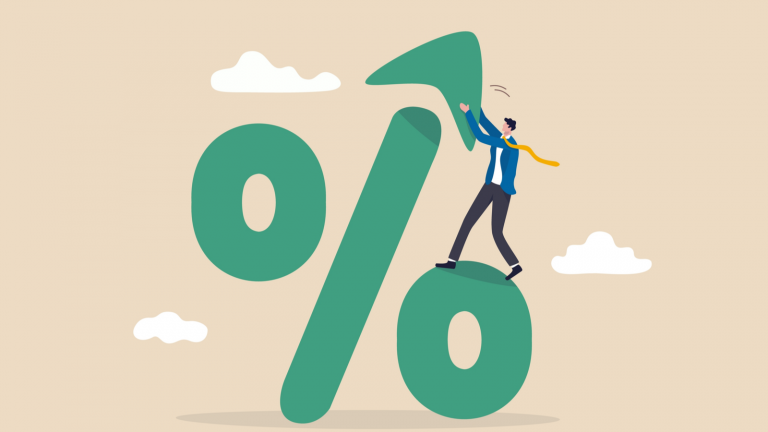In a low-interest rate world, savings accounts get no respect. They give you liquidity and safety of principal, sure. But growth? Not a chance. And unfortunately for cash hoarders, that’s precisely the environment we’ve been in for over a decade.
The return on money parked at the bank has hovered near zero. It’s been a depressing reality for risk-averse savers unwilling to venture into assets like stocks and bonds to generate a return on their money. But the clear and present danger of inflation is changing the landscape. Interest rates are rising, which should mean savings account yields finally get a boost.
And while the increase may be slow and less generous than you might hope, even a push to 2% or 3% will be a refreshing change of pace to those who only know of higher yields from history books.
Why Are Interest Rates Going Up?
Interest rates are rising because of inflation. Inflation is increasing because of many factors, including supply chain bottlenecks, intense demand from cash-rich consumers and corporations, and monetary and fiscal policy that proved a little too generous for too long following the global pandemic. Mix it all together, and you have the classic culprit for inflation: too many dollars chasing too few goods.
To grasp the link between interest rates and inflation, you first must understand the role of the Federal Reserve, which is America’s central bank. The institution has a dual mandate to promote price stability and full employment. Unfortunately, both objectives are often at odds with each other. That is, they lie on opposite ends of a teeter-totter. The Fed’s focus thus becomes a matter of which is the greater concern. For over a decade following the great financial crisis of 2008, the central bank’s priority was aiding the economy to drive us back to full employment (often defined as an unemployment rate of 4% or less).
But priorities are shifting with inflation now roaring back, and full employment effectively achieved. The central bank has embarked on a new campaign to squash inflation and make price stability great again. Though it has many tools at its disposal, interest rates are the one that commands the most attention. Here’s how it works.
When the economy is struggling, and unemployment is climbing, the Federal Reserve lowers interest rates to cheapen the cost of capital and spur economic growth. Low rates incentivize consumers and businesses to borrow and spend.
When the economy is booming, and prices climb too quickly, the Federal Reserve raises interest rates to increase the cost of capital and tap the breaks on economic growth. High rates discourage borrowing.
Over the past six months, the monetary magicians at the Fed have lifted short-term interest rates from zero to 1%, and Wall Street expects the raises to keep on coming. According to this handy FedWatch tool, the market is pricing in a climb to 3% by year-end.
Will Savings Account Yields Rise?
Yes, savings account yields will rise along with interest rates. And here’s why.
While savings account yields don’t directly track the interest rates set by the Fed, they are correlated. Think about the business model of a bank. They borrow money from depositors to make mortgage loans, auto loans, business loans and the like. How much interest they’re willing to pay on deposits is partly a function of how much interest they can collect on loans. If they charge 4% on a mortgage loan while paying 1% on the deposits used to fund the loan, they’re capturing a profit on the spread. If mortgage rates rise (and they do when the Fed starts raising interest rates), the bank can afford to offer more interest on savings accounts while still maintaining its profit margin.
Here’s a second reason your savings account yield should start trekking higher. The interest on Treasury bills (T-bills) is rising as the Fed raises rates. Banks don’t only use deposits to fund loans; they also invest them in liquid, risk-free investments like T-bills. One year ago, 3-month T-bills were yielding 0%. Now, they’re paying 1.16%. If rates rise to 3% by the end of 2022 as expected, then 3-month Treasurys should follow suit.
Competitive banks doing their best to pass these rate increases to customers should offer a savings account yield that resembles the 3-month Treasury yield. If yours doesn’t, then you’re living beneath your privileges.
2 Tips to Get Higher Interest Rates on Your Savings
Now that we’ve addressed what higher interest rates mean for your savings, here are two tips to increase your yield.
First, shop around. Google “high yield savings accounts” to see what the best banks are paying. At the time of this writing, Marcus by Goldman Sachs (NYSE:GS) offered 0.85%, which is only about 20 basis points lower than 3-month T-bills.
Second, set up an account at Treasury Direct to buy T-bills from the government. You can easily link your bank account and buy Treasurys in low-dollar increments. Think of it as a way to cut out the middle man.
On the date of publication, Tyler Craig did not have (either directly or indirectly) any positions in the securities mentioned in this article. The opinions expressed in this article are those of the writer, subject to the InvestorPlace.com Publishing Guidelines.

